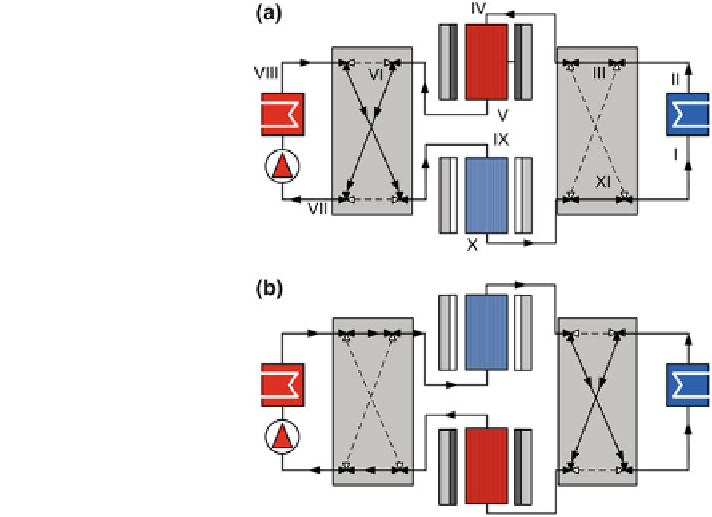Environmental Engineering Reference
In-Depth Information
Fig. 8.17 A magnetocaloric
device with a rotary
movement of the magnet
assembly over two static
AMRs with the application of
the switching valve system
and the uni-directional pump
(a upper AMR magnetized,
lower AMR demagnetized; b
upper AMR demagnetized,
lower AMR magnetized),
classication no: R20(3)1(5)
(6)01101(12)
(stator) and the rotary part (rotor) (Fig.
8.18
b). The simplest case for the latter is to
apply a double or triple Halbach structure. However, this will not be the most cost-
effective solution. A more effective solution can be provided by the rotation of the
magnetic
eld source, such as, for example, shown in Fig.
8.19
.
According to Fig.
8.19
(left), a four-pole rotating magnet provides for the
magnetization and demagnetization of eight AMR beds. Such a magnet assembly
can be simply designed to be longer in the case of axial
ow (parallel to the
rotation axis), when a longer AMR is required. This certainly represents a simpler
construction over applications with a radial or azimuth
fl
uid
fl
ow through the AMR.
This is especially so if the up-scaling of devices is required. In Fig.
8.19
(right)
another example is shown in which the two-pole magnet is applied. In this case we
show two different examples of the magnetization of AMRs. However, in most
cases such an arrangement will provide a smaller magnetic
fl
uid
fl
fl
ux density than in the
case of Fig.
8.19
(left).
Another very important issue that needs to be addressed in the case of rotating
magnetic
eld sources is to follow the design and knowledge from permanent
magnet motors. Such an example is shown in the two cases of Fig.
8.20
.
In the cases a
c for Fig.
8.20
, we can follow the knowledge on the design of
permanent magnet motors in order to provide an ef
-
cient solution for the magnetic
fl
ux density in
such a particular case of multiple pole magnets will be, in most cases, low.
Therefore, compared to permanent magnet motors, the design architecture should
be modi
ux distribution as well as to minimize the torque. The magnetic
fl
ed for application of magnetic refrigeration.

Search WWH ::

Custom Search